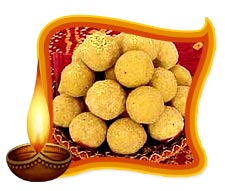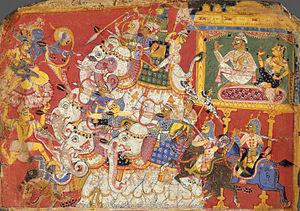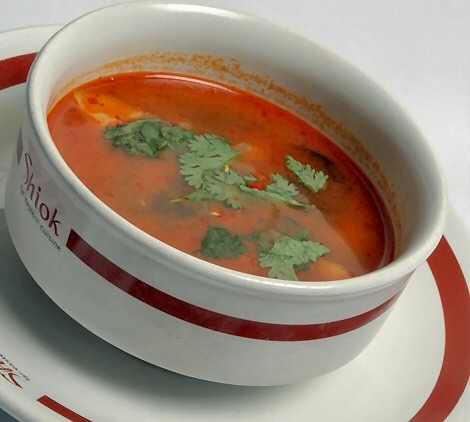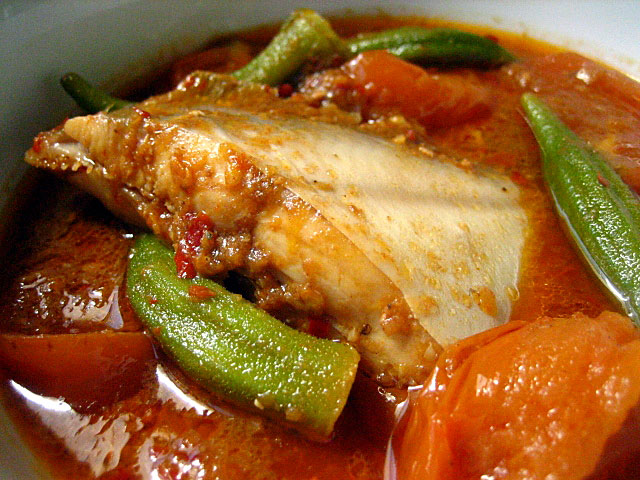Makes 2-3 bowls of soup
Preparation time: 15-20 minutes
WHAT YOU NEED
Good quality Chinese chicken stock - 2 cups (500 ml) (not the crap you get from stock cubes)
Fresh or frozen
lemongrass (dried lemongrass sucks) - 1 fat stalk (or 2 thin ones)
Galangal - 1 tablespoon (fresh is preferable, dried will do in a pinch - soak dried in warm water prior to use)
Nam Prik Pao (Thai roasted chilli paste) - 1-2 tsp (depends on how hot your brand of paste is)
Thai bird's eye chillies (or Serrano chillies) - 4-5 (big slices so you can avoid them easily)
Onion - 1/4 of a medium onion (sliced)
Sugar - 1/2 tsp
Coriander (cilantro for you Americans) leaves - 4 tbsp
Boneless chicken
breast - 50 gm (chopped)
Straw mushrooms (or regular button mushrooms) - 4 (sliced)
Spring/Green onions - 3 tbsp (sliced thin)
HOW TO MAKE IT
For the lemongrass, use only the bottom white part (about 6 inches) and discard the woody grass part of it. With the flat side of a cleaver or a heavy object, pound and bruise the lemongrass so it releases the flavour. Cut into 2 inch segments.
Put lemongrass, galangal, fish sauce and stock into a pot and bring to a simmer. Cover and simmer for another 15 minutes.
Uncover the pot and add the Kaffir lime leaves, chilies, onion, sugar and chicken pieces.
Simmer for 2-3 minutes, then add Nam Prik Pao and mushrooms. Simmer for yet another 2 minutes. Now add the spring onions and let it simmer for 30 seconds.
Turn off the heat, add lime juice and garnish with coriander leaves. Test for saltiness and sourness. If required, adjust with more fish sauce (salt) and lemon juice (sour).
This makes a medium-hot bowl. Some prefer to have it spicier. Find your own comfort level. Remove the lemongrass and galangal before serving if you like. They're not particularly edible. Good for colds, good for a whole lotta things. Your grandma's chicken soup can't hold a candle up to this one. :)
CHEF'S NOTES
1) To turn this into Tom Yam Goong (Prawns), use prawns instead of chicken but add it only in the final 1 minute of cooking. Prawns cook very fast and will continue to cook in the warm stock. Overcooking them will turn them tough and leathery. Instead of chicken stock, use water and add some prawn shells with the lemongrass. This will give you prawn stock. Remove shells (duh!) before adding other ingredients. Frozen prawns (nude) suck. Don't use them.
2) Good chicken stock is very simple to make. Take 1 kg chicken wings, throw in a couple of drumsticks for meat, put it in a tall stock pot, cover with 2 litres cold water, and bring to a simmer. When the scum rises to the top, skim to another bowl with a shallow spoon. This should take 10-20 minutes. When the stock is clear, toss in 4 spring onions (scallions; use only the white part), 5-6 slices ginger, and a teaspoon of black peppercorns. Let this simmer for 2-3 hours (it should only bubble). Two rules for good stock: a) do not stir and b) do not boil (or it will become cloudy instead of clear.)
After the stock has finished simmering, let it stand for 20 minutes and then using a fine mesh sieve, strain it into another bowl. Using a muslin cloth would be a good idea. Your stock is ready. If you leave it in the fridge, the fat will solidify on the top. Just remove this fat and you have de-fatted, unsalted stock ready for use. You can even reduce the liquid and make stock cubes in the freezer.
3) Galangal has no real substitute. Ginger is the closest but it does a poor job.
4) Kaffir Lime leaves have a unique flavour. Lime zest is the closest thing (use 1-2 tsp) but not quite as good. Dried lime leaves lose flavour and you need to use more.
5) Nam Prik Pao can be made at home but I'm too lazy to tell you how. A regular pure chilli paste mixed with some sugar may be substituted with just about adequate results. Or you can just add more fresh chillies to the soup. If you don't use Nam Prik Pao, your soup will not have a fiery red colour.
6) The strength of lemongrass and lime juice may vary in your part of the world, so use your nose and your tongue to judge proper quantities. When in doubt, use more lemongrass but less lime juice. Then adjust gradually. :)
In temperate climates, you may not get limes. If so, use lemon juice instead, and use more of it than prescribed here.





























